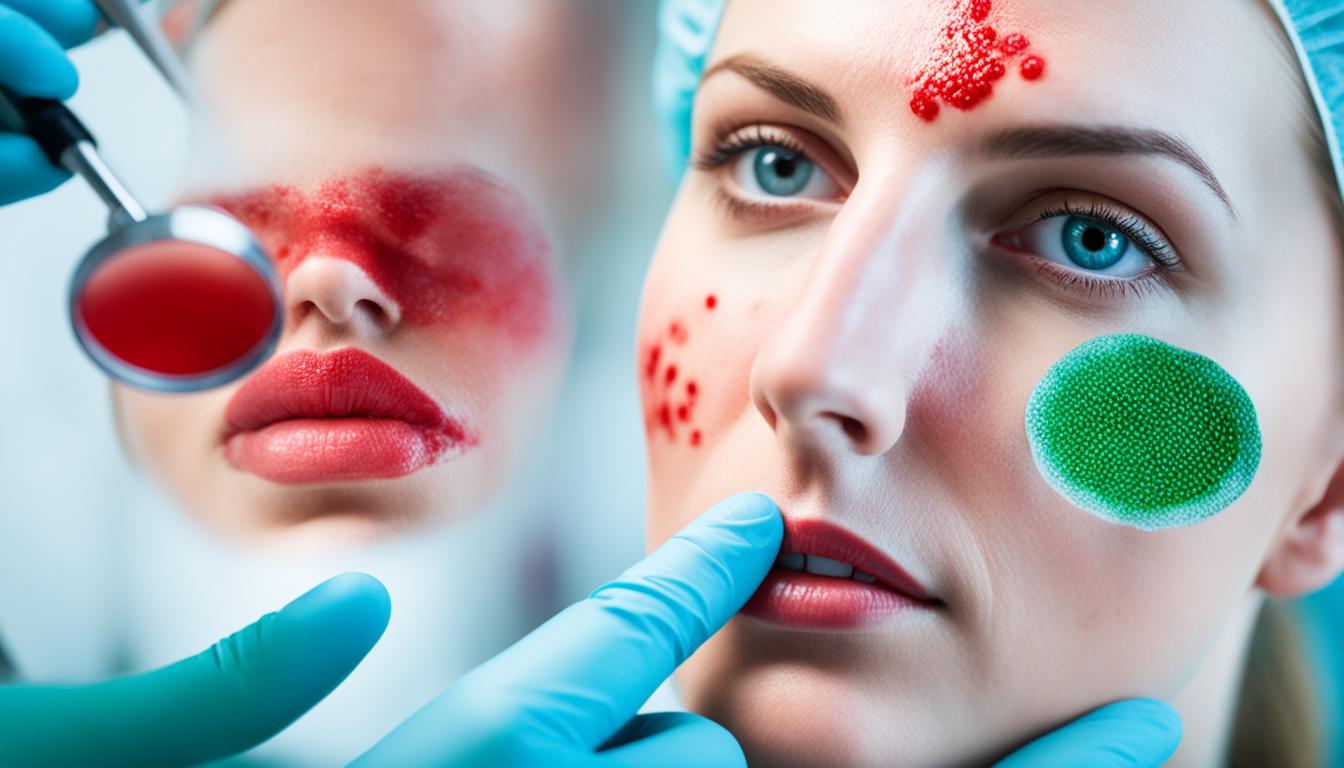Urticaria is a common skin issue that affects 20% of the world’s people. It causes itchy, red bumps or welts and deeper skin swelling. This disease is also known as hives or angioedema.
It happens when certain skin cells are activated, releasing histamine and other stuff. The exact cause isn’t always clear, but it can come from allergies, infections, or some medicines.
To diagnose urticaria, a doctor looks at your skin and asks about your health. Sometimes tests are needed to pinpoint what’s causing it.
Treatments include drugs to reduce itchiness and swelling, like antihistamines and corticosteroids. For severe cases, doctors might consider stem cell therapy.
Research is happening to see how well stem cell therapy works for urticaria. This new treatment could offer long-term relief to those who suffer.
Key Takeaways:
- Urticaria affects a big part of the world’s population, causing red, itchy bumps or deep skin swelling.
- These symptoms happen when certain skin cells release a substance called histamine.
- The cause of this skin issue can be allergies, infections, medicines, or certain skin conditions.
- Doctors diagnose it by looking at your skin, checking your health, and sometimes running tests.
- It can be treated with drugs to lessen symptoms, and in serious cases, with stem cell therapy.
Symptoms and causes of Urticaria
Urticaria, or hives, shows up as sudden itchy, red bumps on the skin. These bumps, called wheals or hives, look different and can disappear quickly.
It can also make you swell, especially in the lips, eyes, hands, or feet. This swelling is known as angioedema and affects deeper skin layers.
The exact cause of urticaria isn’t always clear. But, it’s thought to happen when mast cells release histamine in the skin. This release leads to an immune reaction and causes the red bumps and itching.
Many things can set urticaria off. These include:
- Allergies: Things like certain foods, drugs, or the air can cause urticaria. Notable allergens are peanuts, shellfish, pollen, and pet dander.
- Infections: Viruses or bacteria like the common cold, strep throat, or hepatitis can also trigger it.
- Physical contact: Pressure, rubbing, or being too cold or too hot can bring on urticaria. For example, tight clothes or scratching can do this.
- Emotional stress: Intense feelings or stress may cause urticaria in some people.
Figuring out what triggers your urticaria is key to managing and treating it. If you know your triggers, you can avoid them and lessen how often you get outbreaks.
Common Causes of Urticaria
| Cause | Description |
|---|---|
| Allergic Reactions | Urticaria can be triggered by allergic reactions to certain foods, medications, or environmental factors. Common allergens include peanuts, shellfish, pollen, and pet dander. |
| Infections | Certain viral or bacterial infections, such as the common cold or strep throat, can cause urticaria to develop. |
| Physical Stimuli | Physical stimuli such as pressure, friction, or exposure to extreme temperatures can lead to the development of urticaria. |
| Emotional Stress | Intense emotions or stress can sometimes trigger urticaria in susceptible individuals. |
Finding out what causes your urticaria helps a lot in treating and managing it. Avoid your triggers to make outbreaks less severe and less frequent.
Diagnosis and stem cell therapy for Urticaria
Diagnosing urticaria mainly involves looking at a patient’s medical history and doing a physical exam. Doctors check the hives and look for other signs. Sometimes, they run tests or skin prick tests to find what’s causing the problem.
Treatments for urticaria work to lessen symptoms and fix the immune system issues. Antihistamines are often used to lower histamine levels and ease the itch and swelling. For more serious cases, doctors might prescribe corticosteroids to dampen the immune response. Stem cell therapy is a new treatment that aims to balance the immune system back out.
Though still being studied, stem cell therapy for urticaria looks like it could help those not helped by usual methods. Trials are happening to check how well it works and its safety. If it proves to be effective, this therapy may mean a big improvement in life quality for those with long-term issues. But, there’s still more to learn about how stem cell therapy can really help with urticaria.

